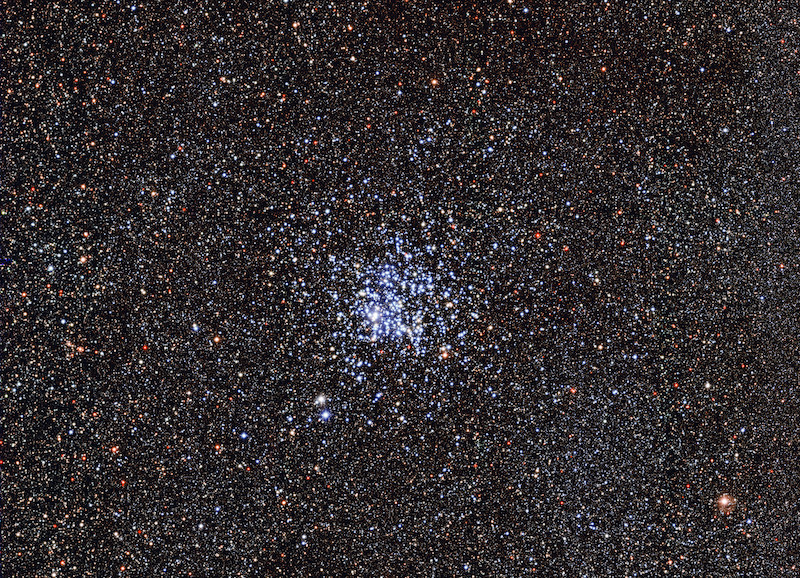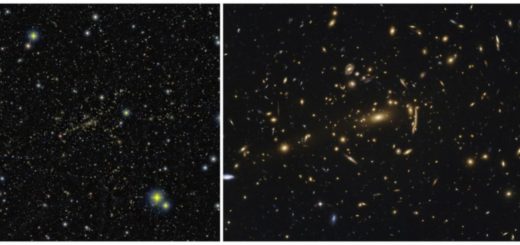Messier 11 Is The Wild Duck Cluster

The Wide Field Imager (WFI) on the MPG/ESO 2.2-metre telescope at the La Silla Observatory in Chile has taken this beautiful image of the open Wild Duck Cluster, Messier 11, or NGC 6705. The blue stars in the centre of the image are the young, hot stars of the cluster. The surrounding redder stars are older, cooler background stars.
The Wild Duck Cluster, also known as Messier 11, is an open star cluster in the direction of our constellation Scutum the Shield. This loose aggregation of stars lies about 6,120 light-years away. It’s quite faint; you’ll need binoculars or a telescope to see it. It consists of sibling stars, born from a cloud of gas and dust in space.
To find it, first locate the bright star Altair in the sky. It is the brightest star in the constellation Aquila the Eagle, and the second brightest star in the Summer Triangle. Altair is flanked on each side by the two moderately bright stars Tarazed and Alshain.
A star map with stars in black on white, with Messier 11 marked as a small yellow circle.
A star map showing Aquila and Scutum. Altair is a very bright star, easily identifiable in the sky since it’s part of the Summer Triangle. Image via Roberto Mura/ Wikimedia Commons.
From Altair, following the chart below, you can star-hop in the southwest direction towards Messier 11. Delta Aquilae is your first hop, about 8 degrees from Altair. (For reference, the width of four fingers held at arm’s length approximates 8 degrees of sky.)
Using binoculars, keep going downward a bit more than twice the Altair-Delta Aquilae distance, till you see a semicircle of stars that pretty much fills your binocular field. The Wild Duck Cluster pops out as a hazy star-like object just beneath this semicircle star pattern.
Star chart of Aquila with five stars and Messier 11 labeled.
Messier 11, the Wild Duck cluster.
If you have a telescope, Messier 11 is best viewed when it’s relatively high in the southern sky. That’s in the wee hours before sunrise in spring, late night in early summer, and mid-evening in late summer and early fall.
Tight collection of whitish stars at the center of the image, with very sparse whitish stars over a wide field of view.
Messier 11, imaged by an 8-inch telescope. Image via Stephen Rahn/ Flickr.
Science and History
Like the Pleiades and the Hyades, Messier 11 (also called M11) is an open star cluster, except that it’s much farther away. The Pleiades and Hyades clusters lie about 444 light-years and 153 light-years away, respectively, while Messier 11 is about 6,120 light-years distant.
An open star cluster is a group of stars that formed from the same giant cloud of mostly molecular hydrogen. These massive clouds, often called stellar nurseries, are so dense that gravitational forces form compact conglomerations of molecular hydrogen that continue to contract until fusion reactions in the stars’ centers ignite the birth of new stars. Initially, the young stars are loosely bound together by gravity but they will eventually disperse over time.
Messier 11, one of the most massive open star clusters that we know of, has about 3,000 stars, with its hot blue stars congregated towards the center. The cluster is thought to have formed sometime between 250 to 316 million years ago. Astronomers refer to it as a metal-rich cluster because a nearby supernova likely seeded its molecular cloud complex with heavier elements.
In 1733, English naturalist William Derham was able to resolve Messier 11 as individual stars through a telescope, and not long after, in 1764, French astronomer Charles Messier added it to his famous catalog. This open star cluster got its unusual colloquial name, “Wild Duck Cluster,” from Admiral William Henry Smyth; while observing the cluster through a telescope in 1835, he noted a V-shaped pattern of its brightest stars that reminded him of the flight formation of wild ducks.
Messier 11 is positioned at RA: 18h 51m 5s; Dec: -6° 16′ 12″



 Creators of mankind
Creators of mankind Description of “Tall white aliens”
Description of “Tall white aliens” Where they came from?
Where they came from? About hostile civilizations
About hostile civilizations The war for the Earth
The war for the Earth “Tall white aliens” about eternal life
“Tall white aliens” about eternal life Video: “Nordic aliens”
Video: “Nordic aliens” Aliens
Aliens Alien encounters
Alien encounters The aliens base
The aliens base UFO
UFO Technology UFO
Technology UFO Underground civilization
Underground civilization Ancient alien artifacts
Ancient alien artifacts Military and UFO
Military and UFO Mysteries and hypotheses
Mysteries and hypotheses Scientific facts
Scientific facts


















